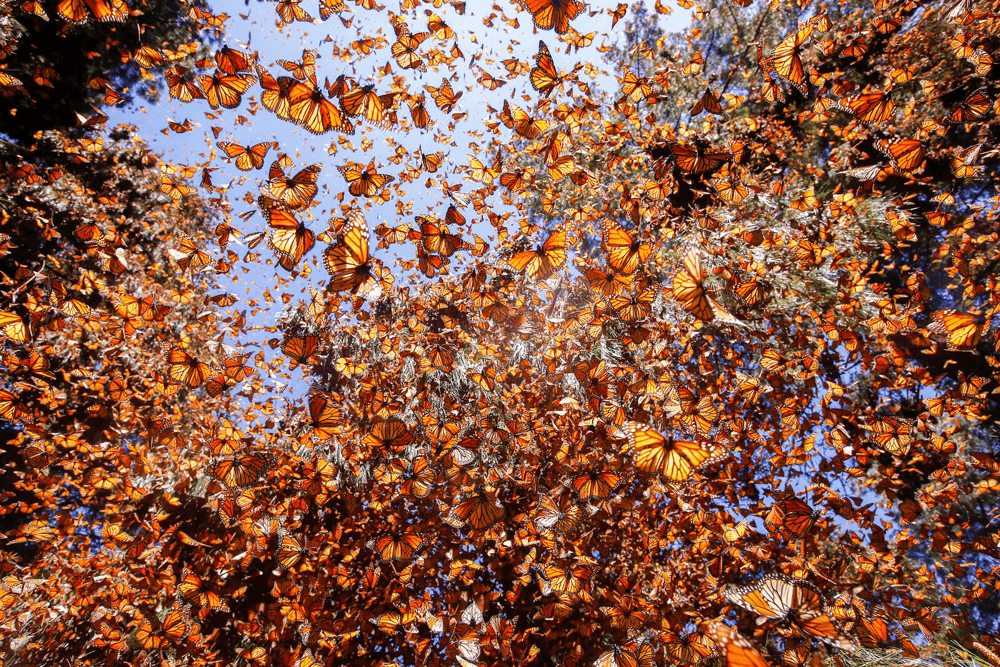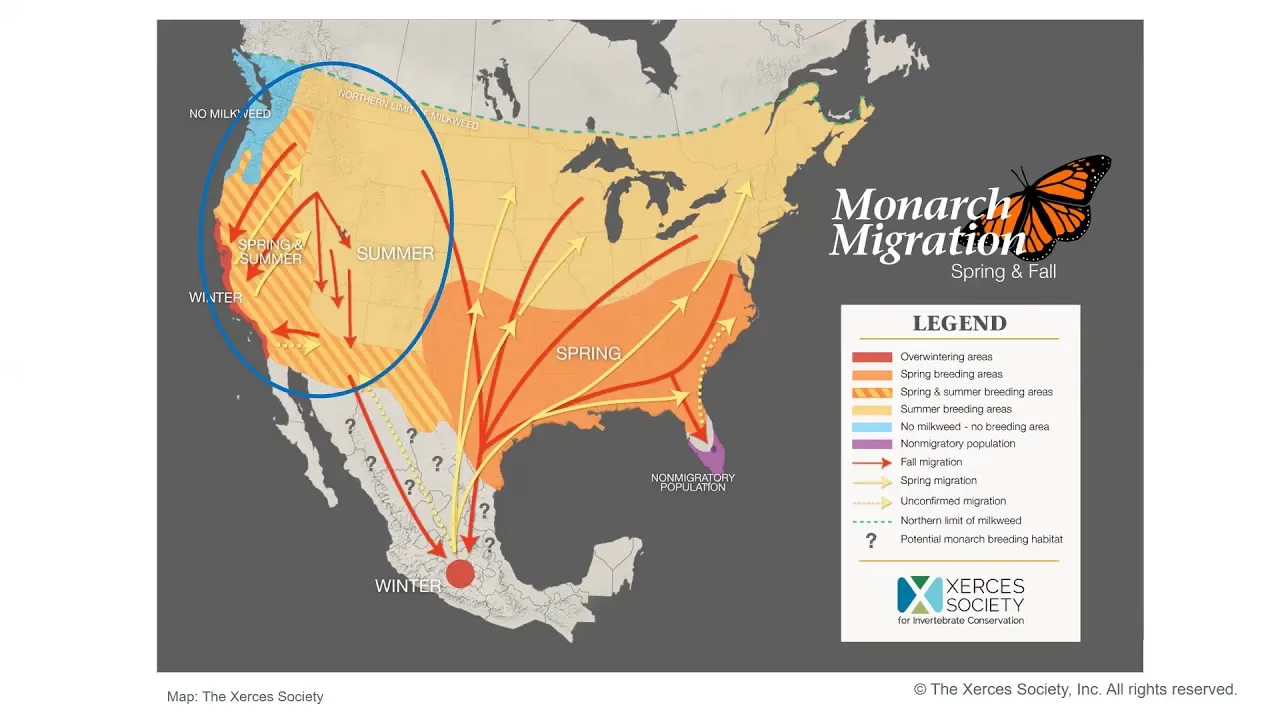Monarch Butterfly Population Rebound
In early 2025, the eastern monarch butterfly population showed a significant recovery. The area occupied by monarchs in Mexico’s wintering forests nearly doubled, covering 4.42 acres this year compared to 2.22 acres in 2024.
This increase is a 99% improvement, though it remains well below historical averages. Experts emphasize that monarchs still need to occupy 6 hectares (approximately 15 acres) to be considered secure .

The Eastern monarch butterfly, one of North America’s most iconic pollinators, is experiencing a remarkable resurgence. Recent surveys reveal that its population has nearly doubled in the past year, marking a significant milestone for conservation efforts and signaling hope for the future of this delicate species.
For decades, scientists and environmentalists have sounded alarms about the monarch’s decline due to habitat loss, climate change, and pesticide use. The latest data, however, suggests that coordinated conservation actions, public awareness, and sustainable land management are producing tangible results, demonstrating the power of collective action in protecting biodiversity.
The Significance of Monarch Butterflies
Monarch butterflies are not just visually stunning—they play a vital ecological role:
- Pollination: Monarchs help pollinate a wide range of native plants, contributing to healthy ecosystems and agricultural productivity.
- Indicator Species: Their population trends reflect the health of broader ecosystems, signaling the success of conservation initiatives.
- Cultural Icon: Monarchs symbolize transformation, migration, and resilience, inspiring communities, artists, and educators.
The surge in the Eastern monarch population is therefore not only an environmental victory but also a cultural and educational triumph, emphasizing the butterfly’s importance beyond its ecological role.
Factors Behind the Population Increase
Several key strategies and environmental conditions have contributed to this promising trend:
1. Habitat Restoration and Milkweed Planting
- Milkweed, the host plant for monarch caterpillars, has been planted extensively across North America by conservation groups, schools, and individual gardeners.
- Restoration of meadows, grasslands, and roadside habitats ensures that monarchs have safe spaces to breed and feed.
- Community-led initiatives encourage native plant landscaping, creating corridors for migration and reproduction.
These habitat improvements have directly supported higher survival rates for eggs and caterpillars, fueling population growth.
2. Reduced Pesticide Exposure
- Increased awareness of pesticide impacts has led farmers and gardeners to adopt pollinator-friendly practices.
- Regulations and incentives for organic and sustainable farming have reduced the exposure of monarchs and other insects to harmful chemicals.
- By limiting the use of neonicotinoids and other toxic pesticides, conservationists have enhanced the survival chances of monarch larvae and adult butterflies.
This shift demonstrates how simple changes in human behavior can create profound ecological benefits.
3. Climate and Weather Patterns
- Recent years have seen favorable weather conditions along the monarch migration routes.
- Mild winters in overwintering sites and abundant spring rainfall have supported milkweed growth and nectar availability.
- Climate stability has allowed butterflies to complete their migration cycles successfully, boosting reproduction rates.
While climate remains a variable factor, this positive trend shows that environmental stewardship can mitigate adverse impacts, enabling monarch populations to rebound.
4. Community Engagement and Education
- Schools, nature centers, and local organizations have led citizen science projects, tracking monarch populations and tagging butterflies for migration studies.
- Public participation has increased awareness of pollinator importance and motivated communities to plant butterfly-friendly gardens.
- Educational campaigns emphasize the role of pollinators in food security and biodiversity, creating a generation of environmentally conscious individuals.
By combining science, education, and community action, these efforts have fostered a nationwide culture of conservation, directly benefiting monarch populations.
The Role of Overwintering Sites
Eastern monarchs migrate thousands of miles to overwintering sites in Mexico, primarily in the Oyamel fir forests of Michoacán:
- These forests provide shelter, stable temperatures, and humidity, essential for survival during winter months.
- Conservation organizations have worked to protect and restore these forests, combating illegal logging and promoting sustainable tourism.
- The increased butterfly numbers suggest that overwintering habitats are thriving, reinforcing the success of coordinated cross-border conservation strategies.
The health of overwintering sites is crucial for long-term monarch survival, highlighting the importance of international collaboration in biodiversity protection.
Success Stories Across Communities
The population surge is mirrored in inspiring stories from local communities:
- School Gardens: Students planting milkweed and native flowers have seen monarch eggs and caterpillars flourish, linking education with hands-on conservation.
- Urban Pollinator Corridors: Cities have converted vacant lots and roadside strips into butterfly-friendly habitats, contributing to population growth.
- Volunteer Monitoring Programs: Citizen scientists tagging butterflies during migration have helped track patterns and identify critical conservation areas.
These stories demonstrate that every individual and community can make a measurable difference, fostering hope and collective pride.
Global Implications and Conservation Lessons
The Eastern monarch’s resurgence offers lessons for biodiversity conservation worldwide:
- Integrated Approaches Work: Combining habitat restoration, public education, and policy initiatives creates measurable ecological outcomes.
- Community Participation is Key: Grassroots action, volunteer programs, and citizen science amplify conservation impact.
- Ecosystem Interconnectivity Matters: Protecting pollinators supports plants, other wildlife, and human food systems, emphasizing holistic environmental stewardship.
This success reinforces the idea that long-term biodiversity gains are possible when humans act responsibly and collaboratively.
The Economic and Social Benefits of Monarch Conservation
Protecting monarch butterflies has wider social and economic advantages:
- Eco-Tourism: Monarch migrations attract visitors to overwintering sites in Mexico, generating income for local communities.
- Agricultural Support: Monarch pollination contributes indirectly to healthy crops and sustainable farming, supporting food security.
- Educational Opportunities: Butterfly conservation projects engage students in science, ecology, and sustainability, building a future generation of environmental leaders.
- Mental and Emotional Well-Being: Observing butterflies and engaging with nature reduces stress, promotes mindfulness, and fosters joy, enhancing community quality of life.
Thus, the monarch’s recovery benefits both ecosystems and human societies, illustrating the interconnectedness of life on Earth.
Challenges and Ongoing Efforts
Despite the encouraging surge, conservationists caution that monarchs remain vulnerable:
- Habitat Loss: Urban expansion and agriculture continue to threaten milkweed availability.
- Climate Change: Unpredictable weather and extreme events can disrupt migration and reproduction.
- Pesticide Use: Ongoing vigilance is required to minimize chemical exposure.
- Invasive Species: Non-native plants and predators may compete with or harm monarchs.
Addressing these challenges requires continued commitment, innovation, and public engagement, ensuring that gains are sustainable and long-term.
The Role of Policy and International Cooperation
Governments and international organizations have been instrumental:
- Monarch Conservation Agreements: Cross-border initiatives between the U.S., Canada, and Mexico support habitat preservation and sustainable land use.
- Protected Areas and Reserves: Designated butterfly habitats ensure safe migration and overwintering zones.
- Funding and Research: Governments and NGOs finance monitoring, restoration, and community education projects, amplifying impact.
This cooperation underscores that biodiversity protection transcends borders, requiring shared responsibility and global commitment.
Stories of Hope and Inspiration
Many individuals and communities share heartwarming stories:
- Teachers Watching Student Enthusiasm: Children witnessing caterpillars transform into butterflies develop a sense of wonder and environmental responsibility.
- Farmers Planting Milkweed Along Fields: Encouraged by conservation programs, farmers see monarchs thrive while maintaining productive land.
- Local Artists and Writers Inspired: The monarch’s beauty inspires art, poetry, and storytelling, connecting culture with nature.
These narratives remind us that conservation success is deeply human, intertwining science, emotion, and community.
Looking Ahead: Ensuring Continued Success
To sustain and build on this progress, experts recommend:
- Expanding Habitat Networks: Increasing milkweed corridors and pollinator gardens to support migration routes.
- Monitoring and Research: Continued population tracking to understand trends and environmental impacts.
- Engaging Youth: Integrating monarch conservation into curricula and community programs.
- Policy Advocacy: Supporting laws and incentives that protect habitats and promote sustainable agriculture.
- Public Awareness Campaigns: Encouraging individuals to plant pollinator-friendly gardens and reduce pesticide use.
By implementing these measures, society can ensure that monarchs not only recover but thrive for generations to come.
Conclusion: A Symbol of Hope and Resilience
The Eastern monarch butterfly’s near-doubling population is more than a statistical achievement—it is a symbol of hope, resilience, and the power of collective action. It demonstrates that human creativity, dedication, and care for the environment can reverse the decline of even the most vulnerable species.
This success story highlights:
- The effectiveness of community-driven conservation initiatives.
- The vital role of habitat restoration and sustainable practices.
- The inspiration that monarchs provide, motivating future generations to protect nature.
- The interconnectedness of ecosystems and human well-being.
As Eastern monarchs take to the skies, migrating gracefully across thousands of miles, they carry a message: When people and nature work together, recovery and growth are possible. Their resurgence is a testament to what determination, collaboration, and love for the natural world can achieve.
The near-doubling of the Eastern monarch butterfly population reminds us that even small actions—planting a milkweed, reducing pesticide use, participating in citizen science—can create monumental change. It is an invitation for all of us to play a role in protecting our planet, one butterfly at a time.
Stay Inspired with More Hopeful Environmental News
If this butterfly comeback made you smile, here are more uplifting stories showing how conservation, kindness, and community efforts are restoring the planet:
- Great Barrier Reef Shows Signs of Recovery ↗ – A powerful reminder that even the most fragile ecosystems can bounce back with dedicated care.
- Mother–Daughter Duo Creates a Nature Lover’s Paradise ↗ – A heartwarming transformation that turned land into a thriving sanctuary.
- South Australia Celebrates Bumper Calving Season for Southern Right Whales ↗ – A remarkable milestone showcasing the success of marine conservation.
Boost Your Motivation with This Uplifting Resource
Happy Thoughts ↗ – A refreshing, feel-good collection of positive thoughts to brighten your day and lift your spirit.
